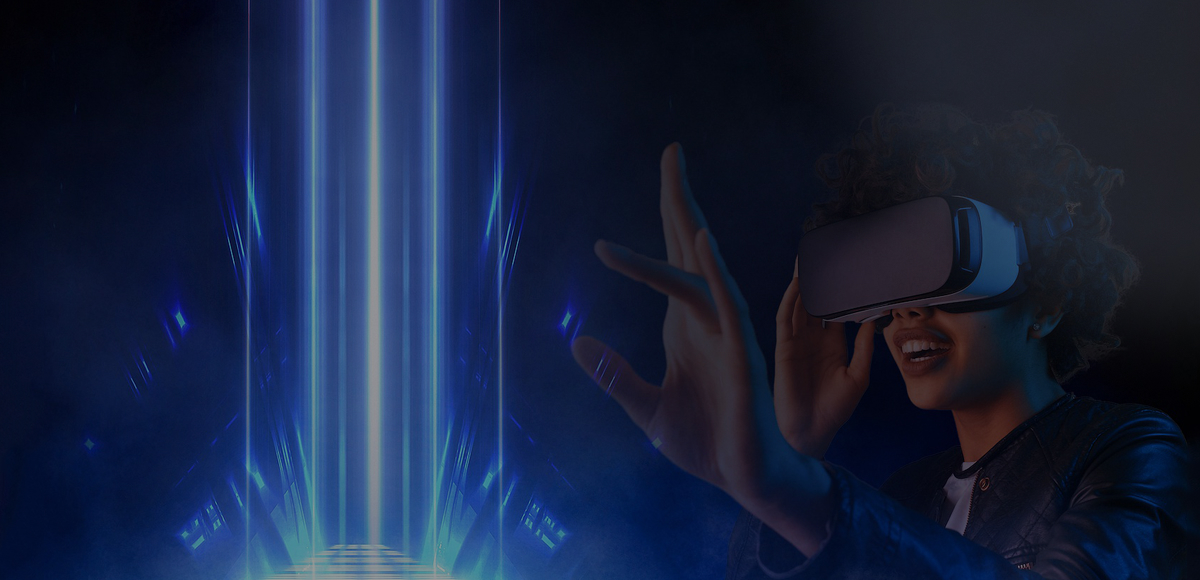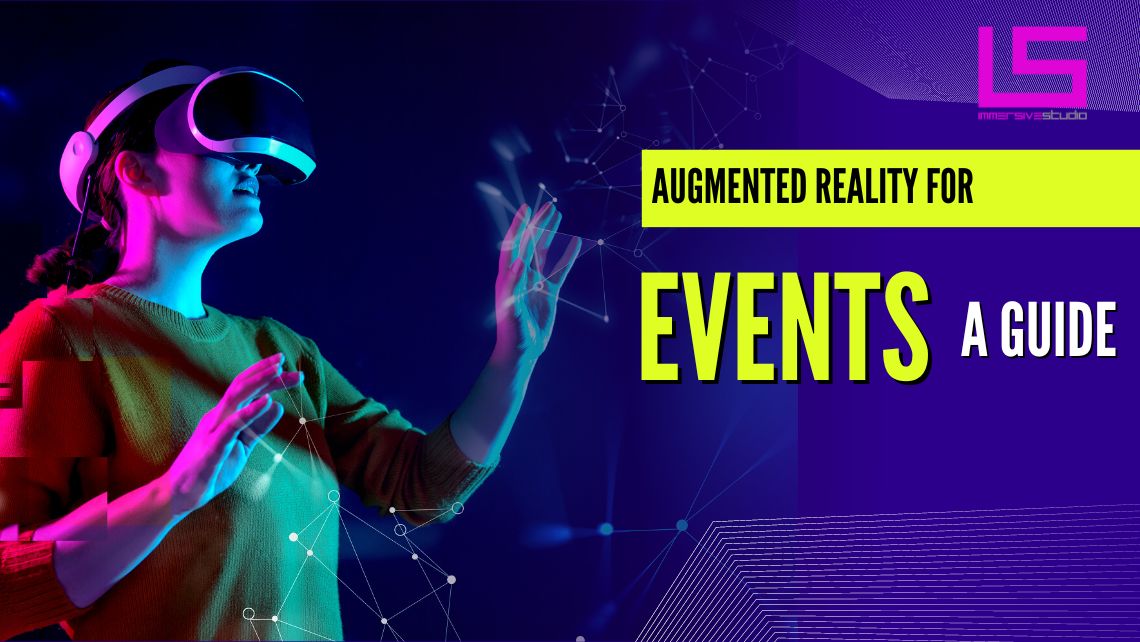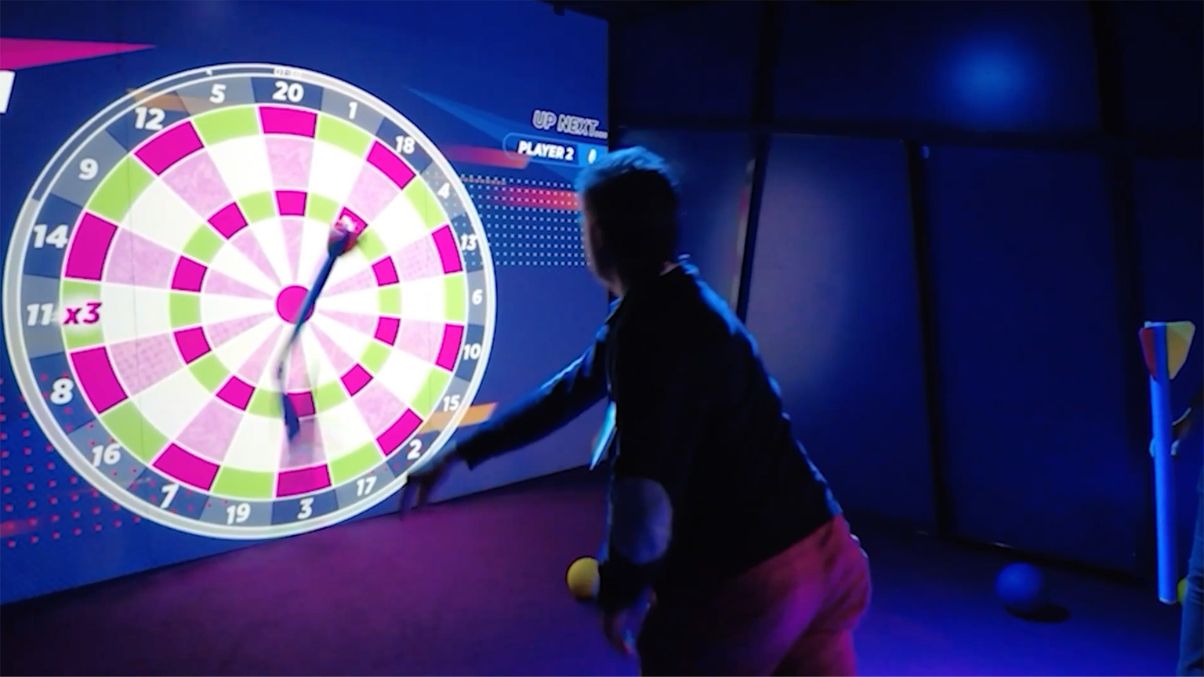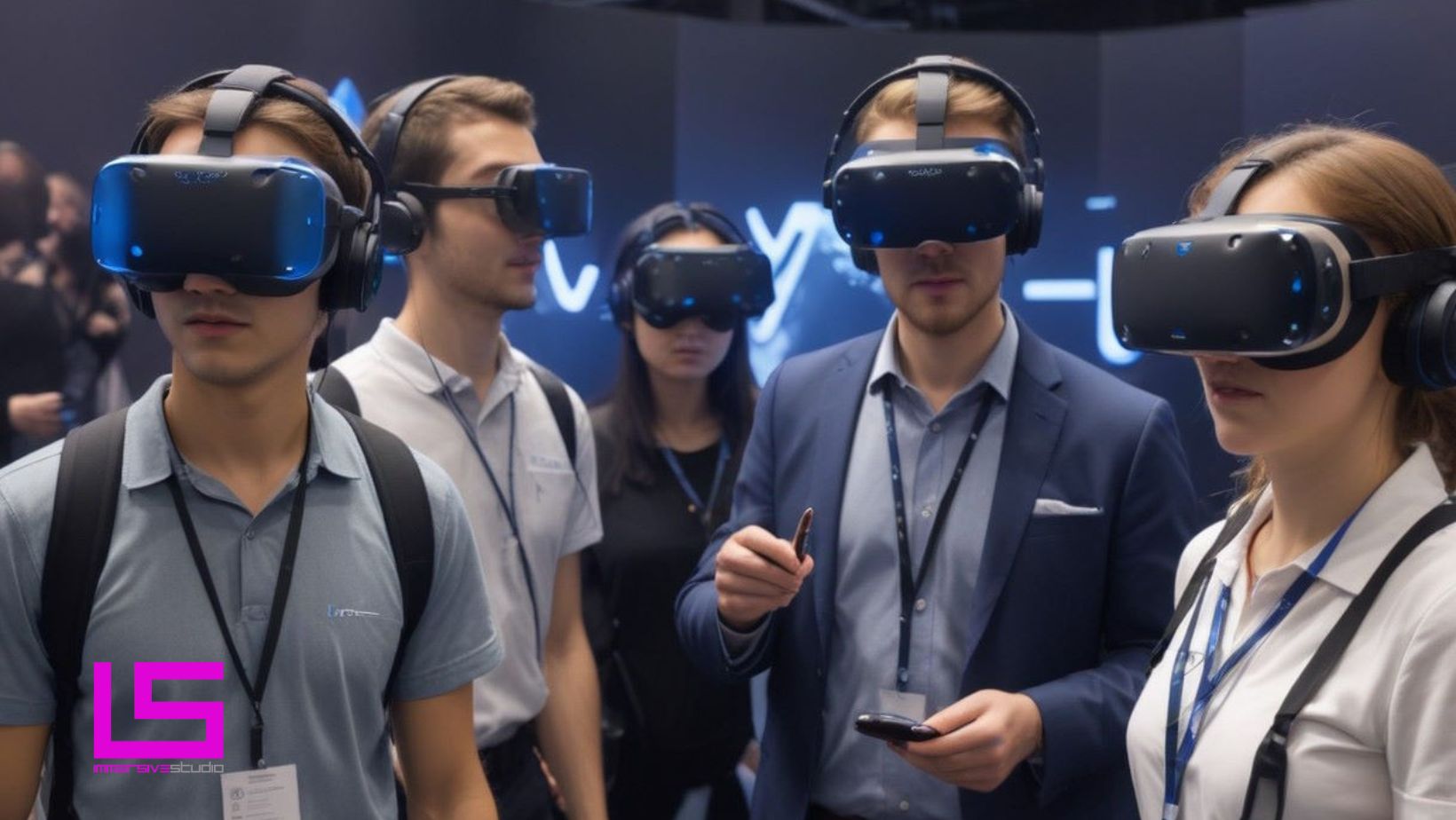
Augmented Reality for Events: A Guide

Augmented reality (AR) is a technology that overlays digital content onto the real world, creating a mixed reality experience that enhances and enriches the physical environment. AR can be used for various types of events, such as trade shows, conferences, parties, wayfinding and more, to create immersive and engaging experiences for attendees, exhibitors, and organizers.
AR can offer many benefits for events, such as
- Increasing the attention and retention of the attendees, by creating a more interactive and memorable experience that stimulates their senses and emotions
- Increasing the engagement and interaction of the attendees, by creating a more personalized and customized experience that allows them to explore and manipulate the content and the environment at their own pace and preference
- Increasing the conversion and loyalty of the attendees, by creating a more convincing and compelling experience that showcases the value and benefits of the products and services in a realistic and tangible way
- Increasing the innovation of the exhibitors and organizers, by creating a more distinctive and creative experience that stands out from the crowd and showcases their competitive edge and unique selling proposition
However, using AR for events also requires careful planning and execution, as there are many factors and challenges that need to be considered and addressed. In this blog, we will provide you with a guide on what to consider when planning to use AR for your events.
How to Maximize the Space You Have to Work Within
One of the main advantages of using AR for events is that it can help you maximize the space you have to work within, by creating virtual content that can expand and transform the physical space. For example, you can use AR to create a model of your product, by overlaying a digital layer onto the existing event space, which attendees can explore without having to physically accommodate the product within the space. With space being a premium, this can be highly beneficial for large scale products. You can also use AR to create virtual products that have maybe not yet been manufactured, that can be displayed and interacted with in the event space, such as a holographic car or a 3D model of a building.
However, to maximize the space you have to work within, you also need to consider the following factors:
The size and shape of the space
You need to measure and map the space you have to work within and determine the best locations and orientations for your AR content and devices and trigger points. You also need to consider the natural and artificial lighting, the acoustics and how they may affect your AR experience.
The number and type of attendees
You need to estimate and plan for the number and type of attendees with expected footfall you expect to have at your event, and how they are going to interact with your AR content and devices. You also need to consider the demographics, preferences, and behaviors of your attendees, and how they may influence your AR event.
The goals and objectives of the event
You need to define and align your goals and objectives for the event, and how they relate to your AR content and devices. You also need to consider the message and story you want to convey through your AR experience, and how they may resonate with your attendees always thinking about how to make the experience simple, informative and easy to activate.
What Technology You Should Use for Your Experience
Another important aspect of using AR for events is choosing the right technology to deliver your experience, as there are many options and variations available in the market. The main types of technology you should be using to deliver your AR experience are:
The AR devices
These are the devices that enable the users to see and interact with the AR content, such as smartphones, tablets, headsets, glasses, or projectors, large format screens and video walls. You need to choose the AR devices that best suit your AR content and your event space, and that offer the best performance, quality, and usability for your attendees. You also need to consider the cost, availability, and compatibility of the AR devices, and how to distribute and maintain them at your event, the main two smart devices are obviously going to be Android and Apple so make usre you develop your AR app fro both platforms so you don’t limit the access for potential attendees.
The AR Software
These are the software and hardware platforms that enable the creation and delivery of the AR content, such as ARKit, ARCore, Vuforia, or Unity. You need to choose the AR platforms that best support your AR content and your AR devices, and that offer the best features, functionality, and flexibility for your AR experience. You also need to consider the development, deployment, and integration of the AR platforms, and how to update and optimize them.
The AR content
These are the digital contents that are overlaid onto the real world, such as 3D models, animations, images, videos, sounds, or texts. You need to choose the AR content that best matches your goals and objectives for the event, and that offers the best value and benefits for your attendees. If you are working to a tighter budget, purchasing pre existing models may be more cost effective than creating 3D models from scratch for example. You also need to consider the design, development, and delivery of the AR content, and how to customize and personalize them at your event.
Safe Zones and How Much Space You Need
Another crucial factor in using AR for events is ensuring the safety and comfort of your attendees, as they may be moving and interacting with the AR content and devices within the event space especially if you are gamifying a space and expect the user to find rewards hidden within the AR overlayed experience ( think of easter eggs in video games) . To ensure the safety and comfort of your attendees, you need to create and maintain safe zones and adequate space for your AR experience, by considering the following aspects:
The physical boundaries and obstacles
You need to identify and mark the physical boundaries and obstacles in your event space, such as walls, doors, windows, furniture, or equipment, and avoid placing your AR content and devices near or on them. You also need to clear and secure the space from any potential hazards or distractions, such as wires, cables, liquids, or debris, and ensure that there is enough lighting and ventilation in the space.
The social and behavioral restrictions
You need to respect and follow the social and behavioral norms of your event space, such as the rules, regulations, and etiquette of the venue, the organizers, and the attendees, and avoid creating or displaying any AR content or devices that may be inappropriate, offensive, or disruptive. You also need to inform and educate your attendees about the AR experience, such as the purpose, benefits, and instructions of the AR content and devices, and obtain their consent and feedback before and after the AR experience.
Physical and mental well-being
You need to monitor and protect the physical and mental well-being of your attendees, as they may experience fatigue, discomfort, or disorientation from using the AR content and devices, especially for prolonged periods of time. You also need to provide and encourage your attendees to take breaks, rest, and hydrate during and after the AR experience, and offer them support and assistance if they need it.
What Connectivity Does Your Event Space Have
Another essential aspect of using AR for events is ensuring the connectivity and reliability of your AR experience, as it may depend on the internet, Wi-Fi, Bluetooth, or GPS signals in your event space. To ensure the connectivity and reliability of your AR experience, you need to check and test the connectivity and availability of your event space, by considering the following factors:
The bandwidth and speed
You need to measure and verify the bandwidth and speed of the internet, Wi-Fi, Bluetooth, or GPS signals in your event space, and ensure that they are sufficient and consistent for your AR content and devices. You also need to consider the number and type of users and devices that may be using the same signals in your event space, and how they may affect your AR experience.
The coverage and range
You need to measure and verify the coverage and range of the internet, Wi-Fi, Bluetooth, or GPS signals in your event space, and ensure that they are adequate and stable for your AR content and devices. You also need to consider the size and shape of your event space, and the location and orientation of your AR content and devices.
Security and privacy
You need to measure and verify the security and privacy of the internet, Wi-Fi, Bluetooth, or GPS signals in your event space, and ensure that they are secure and private for your AR content and devices. You also need to consider the data and information that may be transmitted and received through the AR content and devices, and how to protect and encrypt them from unauthorized access or misuse.
How Phygital Does the Experience Need to Be
Another important question of using AR for events is how phygital does the experience need to be. Phygital is a term that refers to the combination of physical and digital elements in an experience, such as using physical objects or markers to trigger or interact with digital content. Phygital can enhance the AR experience by creating a more seamless and natural integration between the real and virtual worlds, and by adding more value and meaning to the physical objects or markers.
However, phygital also requires more planning and preparation, as you need to design and create physical objects or markers and align them with the digital content. You also need to consider the cost, availability, and maintenance of the physical objects or markers, and how to distribute and maintain them during your event.
Do You Need to Have Brand Ambassadors to Help
Brand ambassadors are people who represent and promote your brand and your AR experience at your event, such as staff, volunteers, or influencers. Brand ambassadors can help you with:
- Attracting and inviting attendees to try your AR experience, by creating awareness and interest, and by offering incentives or rewards
- Guiding and assisting attendees with using your AR experience, by providing instructions, tips, and feedback, and by troubleshooting any issues or problems
- Engaging and interacting with attendees during and after your AR experience, by creating a positive and memorable impression, and by encouraging them to share and recommend your AR experience to others
Brand ambassadors can enhance your AR experience by creating a more human and personal connection with your attendees, and by adding more value and meaning to your AR content and devices. However, brand ambassadors also require more training and supervision, as you need to ensure that they are knowledgeable and skilled in using your AR content and devices, and that they are aligned and consistent with your brand and your goals and objectives for the event.
How to Get More People Using Your Setup
Another key challenge of using AR for events is how to get more people using your setup, as you may face competition and distraction from other exhibitors and organizers, and you may have limited time and space to reach and engage your audience. To get more people using your setup, you need to consider the following strategies:
- Create a compelling and attractive AR experience, that showcases the value and benefits of your products and services, and that appeals to the needs and interests of your attendees. You also need to create a clear and catchy name and logo for your AR experience and use them consistently and prominently in your marketing and communication materials.
- Promote and advertise your AR experience, before, during, and after the event, using various channels and platforms, such as social media, email, website, blog, press release, or flyer. You also need to use relevant and effective keywords, hashtags, and tags, to increase the visibility and discoverability of your AR experience, and to target and segment your audience.
- Create a buzz and a word-of-mouth effect, by creating and sharing user-generated content, such as photos, videos, testimonials, or reviews, that feature your AR experience and your attendees. You also need to encourage and incentivize your attendees to create and share their own user-generated content.
- Create a sense of urgency and scarcity, by creating and communicating a limited time and space offer for your AR experience, such as a special discount, a free trial, a giveaway, or a contest. You also need to create and communicate a clear and strong call-to-action, that motivates and directs your attendees to try your AR experience, and to act fast and now, before they miss the opportunity.
Dwell Time and Footfall
Another important metric of using AR for events is dwell time and footfall, which measure the number and duration of the attendees who visit and use your AR experience. Dwell time and footfall can indicate the level and quality of the engagement and interaction of your attendees, and the impact and outcome of your AR experience.
To measure and optimize dwell time and footfall, you need to consider the following factors:
- The location and visibility of your AR experience, and how easy and convenient it is for your attendees to find and access it. You also need to consider the traffic and flow of your event space, and how to position and orient your AR experience to maximize the exposure and attraction of your attendees.
- The design and layout of your AR experience, and how comfortable and enjoyable it is for your attendees to use and explore it. You also need to consider the size and shape of your AR content and devices, and how to arrange and display them to optimize the space and the user experience of your attendees.
The content and value of your AR experience, and how informative and entertaining it is for your attendees to see and interact with it. You also need to consider the length and depth of your AR content, and how to balance and adjust them to suit the needs and preferences of your attendees.
Final Words
AR is a powerful and versatile technology that can transform the events industry by creating immersive and engaging experiences for attendees, exhibitors, and organizers. However, using AR for events also requires careful planning and execution, as there are many factors and challenges that need to be considered and addressed.
AR still has a long way to go but we are in no doubt that AR will become the next big technology disruptor as the way we like to experience information is changing and devices are getting more powerful which enables AR creators do more innovative things.
We hope this blog has been helpful and informative for you, and that you are inspired to explore using AR for your next event. If you are interested in creating an amazing AR experience for your business, contact us today and let us show you how Immersive Studio can help you create stunning AR experiences for your events. Immersive Studio leverages the advanced capabilities of Vizrt to create cutting-edge broadcast graphics that captivate and engage audiences. You can also drop us a message on Facebook, LinkedIn, or Instagram.


